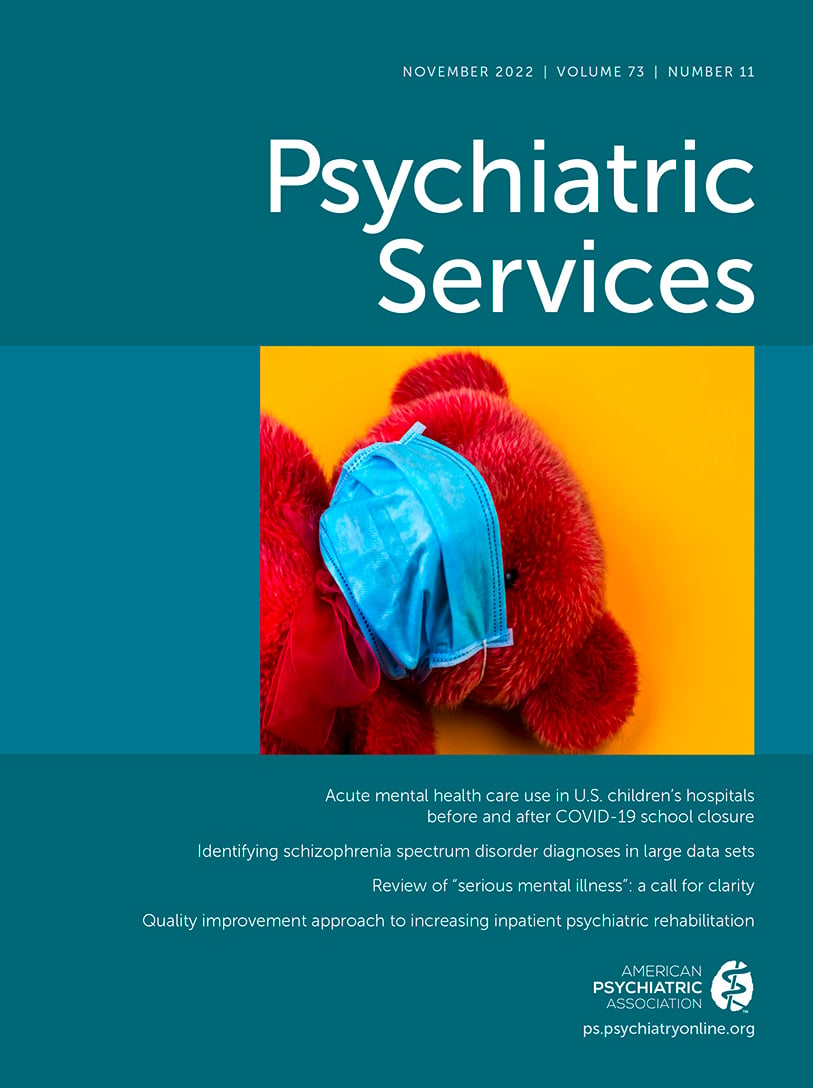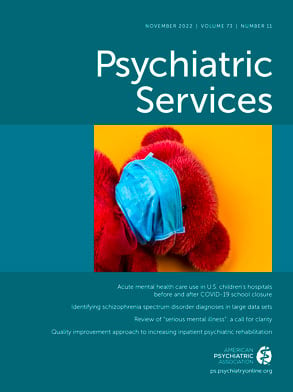Screening for HIV and viral hepatitis as well as vaccination against hepatitis A virus (HAV) and hepatitis B virus (HBV) are highly recommended for people in high-risk groups, such as individuals with serious mental illness (
1,
2). Initially piloted in 2002 (
1), the screening, testing, immunization, risk reduction, and referral (STIRR) intervention has been shown to increase rates of testing for hepatitis and HIV and immunization against HAV and HBV, and improve patients’ knowledge about risks and boost motivation to decrease risky behavior (
1,
3), making it an ideal model for supporting individuals with serious mental illness through all stages of the continuum of care. Participants in this project were offered testing for hepatitis C virus (HCV) and HIV, along with HAV and HBV. Participants who tested positive for HCV, HIV, or both were provided linkage to care, and participants eligible for HAV/HBV vaccination were offered a vaccine.
In a previous study (
4), we presented preliminary findings of HCV continuum of care among the current sample of African American adults with serious mental illness who received the colocated STIRR intervention in a community mental health center in Baltimore. This sample was chosen because African Americans are overrepresented among individuals diagnosed as having HIV in Baltimore (
5), in part because of increased rates of poverty, disease stigma, and limited access to health care, which place racial-ethnic minority groups at elevated risk for contracting infectious diseases (
3). This study aimed to update findings on the HCV continuum of care with complete follow-up data for this sample, including rates of HAV and HBV vaccine acceptance, and to identify diagnostic and demographic variables that predict the likelihood of declining to receive a vaccine.
Methods
All procedures were approved by the University of Maryland Institutional Review Board. Data were collected from February 2015 to July 2019. The study procedures were fully explained to all clients before they participated, and all provided written informed consent. Participants completed the requisite pretest counseling for viral hepatitis blood testing. All STIRR services were delivered or coordinated by a registered nurse who was ancillary to the existing clinic staff. All participants received a blood test for HAV, HBV, HCV, and HIV. Blood was drawn onsite during the first visit and processed in the University of Maryland Medical Center laboratory. Vaccines for HAV and HBV were offered onsite on the basis of the results of participants’ blood work or chart review. Participants who showed prior immunity to HBV were offered the two-part HAV vaccine. Participants who showed immunity to neither HBV nor HAV were offered Twinrix, a three-part vaccine that guards against both HAV and HBV. Twinrix was prescribed in accordance with the vaccine’s packaged insert guidelines (
6). Individuals with additional treatment needs for HCV or HIV were referred to the university’s infectious disease clinic. Chart review was used to record patients’
DSM-5 diagnosis (
7). For those with multiple diagnoses, a primary diagnosis was chosen.
Receipt of the STIRR intervention was determined by calculating the number of STIRR participants who attended each STIRR visit and the number of participants who received partial or complete vaccination through STIRR. To determine receipt of continuum of care, we also assessed the number of STIRR participants who received a new diagnosis of HCV after a STIRR blood test and recorded the number of HCV-positive patients who were connected to a treatment provider. The number of patients who were either actively in treatment or cured (as indicated by a sustained viral response) upon STIRR completion was also examined on the basis of chart review.
This study administered participants several assessments, including the Brief Systems Inventory (BSI), AIDS Risk Inventory, and PTSD Symptom Scale (PSS). The PSS is a 17-item self-report assessment that measures the levels of posttraumatic stress symptoms patients experienced in the past month. The scale includes three subscales to measure levels of avoidance, arousal, and reexperiencing. The BSI is a 53-item self-report symptom scale that measures patients’ clinically relevant psychological and general medical symptoms. The BSI includes nine symptom subscales; the data collected in this study focused on paranoid ideation and psychoticism.
The dependent variable, receipt of immunization, was categorized as a binary outcome (i.e., among participants eligible for a vaccine [N=229], those who received at least one dose of the Twinrix or HAV immunization series [N=155] vs. those who declined to receive any Twinrix or HAV vaccination [N=74]). The following independent variables were hypothesized to be risk factors for declining to receive a vaccine: age (older individuals being more likely to assent to receiving a vaccine than younger ones), gender (women being more likely to assent to receiving a vaccine than men), psychotic symptoms (people with less severe psychotic symptoms being more likely to assent to receiving a vaccine than people with more severe symptoms, as measured by the BSI psychoticism and paranoid ideation subscales), trauma symptoms (people with less severe trauma symptoms being more likely to assent to receiving a vaccine than people with more severe symptoms, as measured by total PSS score and the separate subscale scores), and education (people with a 12th-grade education or higher being more likely to assent to receiving a vaccine than people with less education). These independent variables were evaluated in bivariate analysis by using the chi-square statistic for binary independent variables and Student’s t test for continuous independent variables. Using logistic regression, we evaluated whether the above factors (i.e., age, gender, psychotic symptoms, trauma symptoms, and education) were predictive of those who declined vaccination versus those who accepted at least partial vaccination. For comparison, we also calculated the unadjusted odds ratio for each factor. Data analyses were performed with SAS, version 9.1.
Results
In total, 270 African American participants completed a STIRR baseline visit. The mean age of the participants was 47.9 years (
Table 1), most were male (N=148, 55%), and most identified as heterosexual (N=252, 93%). More than half (N=220, 81%) reported having a high school diploma or less, and most were unemployed (N=248, 92%). Participants categorized as unemployed included those receiving social security benefits. The most common psychiatric diagnoses were schizophrenia (N=75, 28%), major depressive disorder (N=69, 26%), schizoaffective disorder (N=66, 24%), and bipolar disorder (N=29, 11%).
Of the 270 participants, 267 (99%) agreed to blood analysis to test for immunity to HAV and HCV. The results of the blood analysis or chart reviews helped us determine which of these participants were generally eligible for any hepatitis vaccine (N=229, 86%), eligible for Twinrix (N=144, 54%), or eligible for an HAV vaccine (N=85, 32%). Reasons for vaccination ineligibility included participants leaving the STIRR program after their first visit (N=12) and previous immunity (N=26).
Of the 144 participants eligible for the Twinrix vaccine, which requires three doses for full vaccination, 5% (N=7) received a single dose, 10% (N=14) received two, and 47% (N=68) received all three doses. An additional 38% (N=55) declined vaccination. Of the 85 participants eligible for the HAV vaccine, 11% (N=9) received a single dose, 67% (N=57) received both indicated doses, and 22% (N=19) declined vaccination. Approximately one-third (N=74, 32%) of vaccine-eligible participants (N=229) declined all offered vaccines.
Bivariate analysis revealed no statistically significant differences between those who received partial or full vaccination and those who declined a vaccination with respect to demographic characteristics; psychiatric diagnosis; or reported levels of psychoticism, paranoia, or trauma-related symptoms. Logistic regression analysis indicated that, compared with individuals with less severe avoidance symptoms, those with more severe avoidance symptoms were more likely to decline vaccination (adjusted odds ratio [AOR]=1.14, 95% confidence interval [CI]=1.01–1.29) (
Table 1). Compared with individuals with less severe arousal symptoms, those with more severe arousal symptoms were more likely to decline vaccination (AOR=0.84, 95% CI=0.71–0.99).
Approximately 15% (N=40) of all participants who completed an initial STIRR visit tested positive for HCV. Of these, 65% (N=26) were newly identified as testing positive for HCV, and 35% (N=14) entered the study with a known HCV diagnosis that was confirmed by study staff via a blood test. Overall, 75% of participants who tested positive (newly diagnosed, N=24; previously diagnosed, N=6) were referred for HCV treatment. Of the participants with a new diagnosis who were referred for treatment, 63% (N=15) began antiviral treatment, and 50% (N=12) were ultimately cured, as indicated by a sustained virologic response (
8). Of the six participants previously diagnosed as having HCV, 50% (N=3) began antiviral treatment, and 33% (N=2) achieved sustained virologic response at study completion. Overall, of the 30 individuals identified as having HCV and who accepted referral to treatment, 47% (N=14) achieved a sustained virologic response.
Discussion
STIRR successfully facilitated vaccination of recipients with no prior hepatitis immunity. More than half of those identified as needing a vaccine ended the study fully vaccinated, and even more ended the study partially vaccinated. Still, about one-third of vaccine-eligible participants declined to receive a vaccine.
In the 2016 National Health Interview Survey, the Centers for Disease Control and Prevention found that, among adults ages ≥19 years, vaccination coverage was 9.5% for HAV and 24.8% for HBV (
9). Vaccination has been established as a safe and cost-effective way to prevent the spread of infectious diseases; however, people with serious mental illness have “significantly decreased access to nonpsychiatric health care services” (
10). Racial-ethnic disparities in vaccine coverage in the United States have been acknowledged and have been attributed to barriers such as affordability of vaccines, affordable and reliable transportation, and access to health insurance (
11). Much research has suggested that physician and provider recommendations significantly influence a patient’s decision to get vaccinated (
12,
13); because patients with serious mental illness are more likely to have access to mental health care rather than general medical care, a joint approach from physicians and trusted mental health professionals could improve patient vaccine comprehension and coverage. This approach may be particularly important for people with co-occurring symptoms of traumatic stress. Avoidance is one of four major symptom categories for posttraumatic stress disorder (PTSD); people who have experienced trauma often avoid experiences, places, or people that trigger stressful memories (
7). Although not all participants had diagnosed PTSD, avoidance was a significant factor in decisions to decline the vaccine.
We found that most STIRR recipients in our sample with an HCV diagnosis progressed successfully from diagnosis to treatment. This finding is consistent with previous results indicating that STIRR is effective for connecting patients with a new diagnosis to treatment (
1,
14). The fact that >80% (N=220) of our sample completed all four STIRR visits indicates that most recipients did not perceive the intervention as overly burdensome.
This study had several limitations, the most prominent of which was the lack of a matched control group. Additionally, the focus on an African American sample in an urban environment may not be generalizable to other samples or settings. Finally, distinct reasons for declining vaccination beyond the measures collected for the study were not recorded for this sample.
Conclusions
In a sample of African American participants with serious mental illness, the STIRR intervention facilitated access to treatment for HCV and high acceptance of hepatitis vaccination. Avoidance, measured with a PSS subscale, was a significant factor in decisions to decline vaccines. A joint approach from physicians and trusted mental health professionals to recommend vaccination and facilitate vaccination follow-up could improve understanding and uptake of vaccination among people with serious mental illness.

